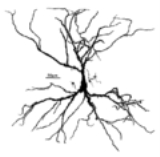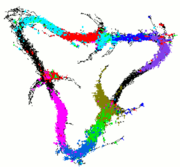
Place cell
Encyclopedia

Hippocampus
The hippocampus is a major component of the brains of humans and other vertebrates. It belongs to the limbic system and plays important roles in the consolidation of information from short-term memory to long-term memory and spatial navigation. Humans and other mammals have two hippocampi, one in...
that exhibit a high rate of firing whenever an animal is in a specific location in an environment corresponding to the cell's "place field". These neurons are distinct from other neurons with spatial firing properties, such as grid cells
Grid cells
A grid cell is a type of neuron that has been found in the brains of rats and mice; and it is likely to exist in other animals including humans...
, border cells
Border cell (brain)
Border cells are entorhinal neurons that are border-sensitive, reacting when a border is present in the proximal environment. Cells with such firing characteristics were predicted by Neil Burgess in 2000, and detected in December 2008, according to a single report by the group of scientists that...
, head direction cells
Head direction cells
Many mammals possess neurons called head direction cells, which are active only when the animal's head points in a specific direction within an environment. These neurons fire at a steady rate Many mammals possess neurons called head direction (HD) cells, which are active only when the animal's...
, and spatial view cells
Spatial view cells
Spatial view cells are neurons in primates' hippocampus which fire when the animal views a specific part of an environment. They respond when a certain part of the environment is in the animal's field of view....
. In the CA1 and CA3 hippocampal subfields, place cells are believed to be pyramidal cell
Pyramidal cell
Pyramidal neurons are a type of neuron found in areas of the brain including cerebral cortex, the hippocampus, and in the amygdala. Pyramidal neurons are the primary excitation units of the mammalian prefrontal cortex and the corticospinal tract. Pyramidal neurons were first discovered and...
s, while those in the dentate gyrus
Dentate gyrus
The dentate gyrus is part of the hippocampal formation. It is thought to contribute to new memories as well as other functional roles. It is notable as being one of a select few brain structures currently known to have high rates of neurogenesis in adult rats, .The dentate gyrus cells receive...
are believed to be granule cells.
Place cells were first described in rats by O'Keefe and Dostrovsky. Based on this discovery, O'Keefe and Nadel hypothesized that the primary function of the rat hippocampus is to form a cognitive map of the rat's environment. Ekstrom and colleagues have found cells with similar properties in the human hippocampus, using extracellular recordings from epilepsy patients undergoing invasive monitoring of their brain activity.
Place fields
Place cells show increased frequency of firing when an animal is in a specific area referred to as the cell's place field. The firing rate increase can be quite dramatic, from virtually zero outside the field to as much as 100 Hz (for brief periods) in the middle of the place field. When a rat forages randomly in an environment, place fields are only weakly modulated by the direction the rat faces, or not at all. However, when an animal engages in stereotyped behaviour (e.g. shuttling between goal locations), place cells tend to be active in the place field on passes in one direction only.On initial exposure to a new environment, place fields become established within minutes. The place fields of cells tend to be stable over repeated exposures to the same environment. In a different environment, however, a cell may have a completely different place field or no place field at all. This phenomenon is referred to as "remapping". In any particular environment, roughly 40-50% of the hippocampal place cells will be active.
In an environment with few or no directional cues (for instance, a circular environment surrounded by black curtains), place fields will tend to have a fixed radial position, but the entire set of place fields may rotate around the maze as predicted by a theory that rats are slowly losing their orientation. If a polarizing cue is introduced (commonly a large white rectangle of paper), place fields will tend to have fixed positions relative to the cue. If the cue is moved while the animal can see it, place fields will tend to remain unaffected; however, if the animal is briefly removed from the environment then the cue is moved and the animal returned, the place fields will rotate so as to maintain their position relative to the cue card. Although visual cues seem to be the primary determinant of place cell firing, it is worth noting that firing persists in the dark, suggesting that proprioception
Proprioception
Proprioception , from Latin proprius, meaning "one's own" and perception, is the sense of the relative position of neighbouring parts of the body and strength of effort being employed in movement...
or other senses contribute as well.
In an environment in which a rat is constrained to walk along a linear track, place fields will often have a directional component in addition to a place component. A place cell that fires at a particular location while the rat walks in one direction along the track will not necessarily fire as the rat visits that location from the other direction. If the rat frequently turns around at the same point, however, place fields there will often be independent of direction.
The size of place fields and their signal to noise ratio varies depending on the region of brain in consideration. In the hippocampus, place fields are smallest and sharpest at the dorsal
Dorsum (biology)
In anatomy, the dorsum is the upper side of animals that typically run, fly, or swim in a horizontal position, and the back side of animals that walk upright. In vertebrates the dorsum contains the backbone. The term dorsal refers to anatomical structures that are either situated toward or grow...
pole, becoming larger toward the ventral pole. This may reflect the topography of projections to the hippocampus. For example, the ventral hippocampus receives much more input from the amygdala
Amygdala
The ' are almond-shaped groups of nuclei located deep within the medial temporal lobes of the brain in complex vertebrates, including humans. Shown in research to perform a primary role in the processing and memory of emotional reactions, the amygdalae are considered part of the limbic system.-...
, while dorsal hippocampus is more preferentially innervated by entorhinal cortex
Entorhinal cortex
The entorhinal cortex is located in the medial temporal lobe and functions as a hub in a widespread network for memory and navigation. The EC is the main interface between the hippocampus and neocortex...
.
Spatial modulated cells are also found in the entorhinal cortex
Entorhinal cortex
The entorhinal cortex is located in the medial temporal lobe and functions as a hub in a widespread network for memory and navigation. The EC is the main interface between the hippocampus and neocortex...
, which feed input from neocortex into the hippocampus. Neurons in the lateral entorhinal cortex exhibit little spatial selectivity, while neurons of the medial entorhinal (MEA) cortex exhibit multiple "place fields" that are arranged in an hexagonal pattern, and are therefore called "grid cells
Grid cells
A grid cell is a type of neuron that has been found in the brains of rats and mice; and it is likely to exist in other animals including humans...
". These fields and spacing between fields increase from the dorso-lateral MEA to the ventro-medial MEA.
Phase precession
The hippocampus is one of many brain structures that can show a characteristic 4–12 Hz oscillation, theta rhythmTheta rhythm
A theta rhythm is an oscillatory pattern in EEG signals recorded either from inside the brain or from electrodes glued to the scalp. Two types of theta rhythm have been described...
, in an EEG recording. The oscillation has been observed in all mammalian species tested. In both rats and humans, it is associated with real or virtual movement through space.
When a neuron discharges, it can be said to fire in relation to the current phase of a theta cycle (0-360 degrees). When a rat enters a cell's place field, the cell will initially discharge when perisomatic inhibition is weakest. For theta recorded in the CA1 pyramidal cell layer, this approximately corresponds with the peak of the oscillation. On each following cycle as the rat progresses through the field, the cell will discharge at earlier and earlier phases, typically stopping just before the trough of the cycle (as recorded in CA1 stratum pyramidale). In other words, the place cell produces a rhythmic discharge of a slightly higher frequency than the ongoing theta oscillation.
Because place fields of different cells overlap, at any particular time the rat will be at different distances in different fields, so each place cell will fire at a different phase of theta, allowing the rat's position to be determined with good precision. This potentially provides an alternative temporal code for location. Phase precession also results in the compression of temporal sequences of place cell firing — a phenomenon believed to facilitate synaptic plasticity
Synaptic plasticity
In neuroscience, synaptic plasticity is the ability of the connection, or synapse, between two neurons to change in strength in response to either use or disuse of transmission over synaptic pathways. Plastic change also results from the alteration of the number of receptors located on a synapse...
. There is evidence that phase precession is related to depolarisation of the neuron, such that the firing rate and firing phase of the cell are tightly coupled, However, phase precession can also be robustly independent of firing rate in freely moving animals. This caveat of phase precession, which alludes to the potential neural mechanisms underlying it, requires further investigation before arriving at a definitive answer.
External links
- Neural Basis of Spatial Memory, from Bristol University
- Place Cells in the Hippocampus

